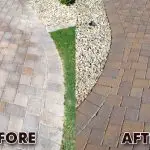With concrete sealer, concrete is made more resistant to weather exposure, grease and oil stains, water as well abrasion and salts. In addition it is essential to bringing out the concrete’s natural beauty and making it easier to clean when applied right. When concrete is sealed, porosity is reduced so that the level of oil absorption is also reduced.

Preparing the surface
Before you can seal concrete, be sure to prepare the surface first. Ensure that you thoroughly clean the surface and remove as much stain as possible. Sweep off any debris that may be present, make use of a degreaser to remove any present grease or oil and scrub off any heavy stains that may be present.
It is recommended that all trace of previously used sealers is removed from the surface before applying the new one. This is because in most cases, when you seal concrete, you will find that no two products of sealants from manufacturers are the same or compatible. One of the best ways you can ensure that the surface is clear of any old sealer is to etch the surface first.
Choosing the right sealant
Before you can seal concrete, ensure that the surface is dry enough for the procedure. Ensure that you have the right sealer present as you want a good end result. There are generally two categories of sealants which are penetrating sealants and topical sealants. With the topical sealants, you get to choose from the three common sealants of Acrylic, Polyurethane and Epoxy. These sealants are simply sprayed, rolled or spread onto the surface of the floor and left to adhere to the floor when dry hence creating a protective layer. Penetrating sealant on the other hand tend to be completely invisible. They tend to get onto the concrete pores and create a chemical reaction that hardens and strengthens the floor.
Applying the sealant
Once you have the floor prepared and the right choice of sealant, it is now time to seal concrete to your heart’s desire. You can make use of a sprayer or roller to seal concrete. The kind of method you will settle with will depend on whether the sealer is water-based or solvent-based. Ultimately though, looking through the manufacturer’s guidelines will help you determine the best method to utilize.
Regardless of the method you use at the end of the day though, maximum coverage should always be the priority. While applying the sealant, be sure not to create puddles and uneven thick areas as they can look pretty messy. In case you have ever painted or seen how painting is done, then you have basically seen how to seal concrete. This is because the sealant is applied in much the same way as you would paint. Much as a number of people prefer using a garden sprayer to seal concrete, it is recommended to use a paint tray and a roller brush to apply the sealant. At the end of the day though, it is better to follow the manufacturer’s guidelines if you wish to seal concrete in the best way possible.
As a side note, safety should not be taken lightly. When applying solvent-based sealant, it is recommend wearing a respirator and ensuring that the workplace is well ventilated. This is because solvent-based sealant tends to emit high levels of volatile organic compounds which are not only harmful when inhaled but also tend to cause flash fires when near a flame. Lastly, ensure that the area is dry before using it. Normally it takes between 12 to 24 hours or longer to dry.




